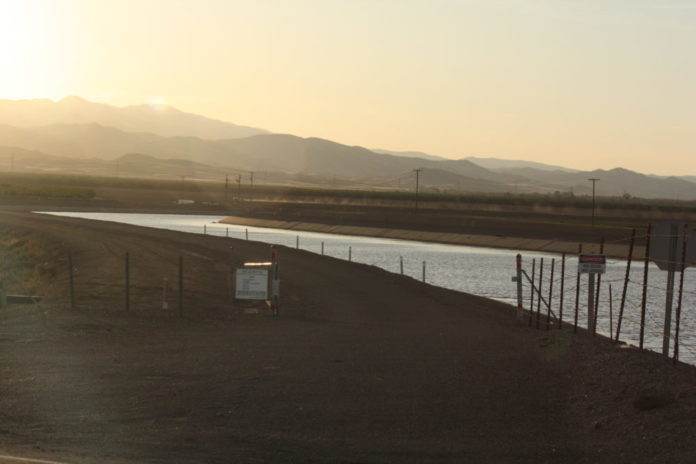 The Exchange Contractors board of directors met on Friday, April 3, 2020 by teleconference. The Los Banos headquarters boardroom is way too small for social distancing. For almost 20-years the first Friday of the month meant getting up before everyone else goes to bed to drive out to Los Banos in time for the Ex Con meeting. That stretch of State Route 152 from High-Way 99 to Los Banos is a long mostly straight road with a few interesting sights.
The Exchange Contractors board of directors met on Friday, April 3, 2020 by teleconference. The Los Banos headquarters boardroom is way too small for social distancing. For almost 20-years the first Friday of the month meant getting up before everyone else goes to bed to drive out to Los Banos in time for the Ex Con meeting. That stretch of State Route 152 from High-Way 99 to Los Banos is a long mostly straight road with a few interesting sights.
There are statues of statues now residing in Oklahoma, slogans on signs that leave no doubt about the signatory’s political views, hot houses full of orchids, US flags big enough to tent a house and my favorite is the small buffalo herd. The clog of morning traffic in downtown Fresno would necessitate leaving extra early and I’d often arrive in time to pick up a meal at a fast food place. The Ex Con boardroom always had fresh fruit, pastries and them little cheese wheels in the wax coverings. But the best part about meeting in person is seeing folks that have become friends. I don’t believe there’s one regular attender of an Ex Con meeting I couldn’t tell a story about their personal kindness towards me.
This is a meeting I rarely miss despite this year’s evidence to the contrary. It’s a good way to start the month – we usually learn something about the San Joaquin River restoration and state water policy we don’t hear in as much detail at other meetings. The San Joaquin River Exchange Contractors Water Authority is made up for four districts. Central California Irrigation District, San Luis Canal Company, Columbia Canal Company and Firebaugh Canal Water District. All of these entities have a legacy passed down from the Miller & Lux ranching empire. (If you don’t know who Henry Miller and Charles Lux were, it’s worth finding out. I’ve heard at one time you could ride a horse from the Idaho/Canadian border to Mexico without leaving land owned by Miller & Lux.) This legacy includes some of the strongest water rights in the state and spurred the development of one of the greatest water engineering and conveyance facilities on earth. If you haven’t ever taken time to read the fine print at the end of this report please do so. It’s a fascinating bit of history.
The Meeting
Changes in the Brown Act have allowed for relaxed and in my opinion better participation. The meeting began at 9:00am. Chairman Jim O’Banion called the meeting and Executive Director Chris White asked everyone to introduce themselves. There were folks I don’t know by name showed up. White commented the turnout is bigger on a phone conference.
O’Banion asked everyone to identify themselves when speaking and I second that. It is very helpful when trying to follow what is happening. If there was a flag salute I didn’t hear it. The agenda was posted online and I also appreciate who the board and management followed the agenda pretty close. That is also helpful. I have a feeling as we all gain more experience with teleconferencing an unofficial protocol will develop organically that will assist in making the meetings easier to navigate.
The minutes were approved, and Joann White gave the financial reports. Chris White said the Del Puerto Canyon feasibility report will be submitted by June and he expects to be in Washington DC to discuss the matter someday soon. If I understood correctly White is optimistic to be able to begin the project next year. The board was presented with a full financing plan and accepted it. Also, each vote in today’s meeting was given verbally by roll call.
Water Report
Water Master Adam Hoffman gave the water report saying Ex Con’s demand was 270 cfs earlier this week. Friant was releasing enough to have a 60 cfs flow into the Mendota Pool. Lake Shasta is holding almost 100 percent of normal capacity for this time of year. Millerton Lake is at 77 percent and Pine Flat is holding 96 percent. There is 14,000 cfs Delta inflow with 5,300 cfs exports. There are more storms forecast which could improve the export pumping later in the year. Apparently Hoffman and White have a bet of some kind going on because Hoffman said White asks him about the weather forecast a dozen times a day. It appears there is going to be a good storm rolling into the Cascade Range this weekend. The estimate is 15,000 cfs inflow but as White mentioned there has been 10 times the inflow in the past. But it does point to a better than worst case scenario for this year.
Ex Con Ex Direct Report
The Executive Director report was next and White said the fish screen for Mendota Pool is moving along with the US Bureau of Reclamation purchasing some property. SLCC General Manager John Wiersma reported the alternative design has some problems but at least there are some answers. He said the work on Sac Dam will be reviewed.
Someone announced, I believe CCC Director Chris Cardella, announced a childless widow who owns property along the SJR passed away and there is some question as to who will speak for the estate in these matters.
White announced there is a deal going on with banked water assets involving the Santa Clara Valley WD and Rosedale Rio Bravo WSD. The SGMA report was attached and the main item was the GSP has been submitted on time.
Policy Report
Policy Director Steve Chedester gave his report saying the Bureau wants to move the fish screen away from the river. This is the problem Wiersma mentioned earlier. There is nothing new to report on Temperance Flat. Nor has there been any activity on the Voluntary Agreements. He said the San Joaquin Valley Water Blueprint is doing a good job in outreach, especially considering the very limited news bandwidth not being occupied by coronavirus.
White spoke about water transfers from both surface and groundwater sources. There are often transfers taking place between Ex Con, the Mendota Pool and other assets to nearby neighbors. The packet included a sample application to show the diligence practiced arriving at a decision to approve or block the transfer. It’s about eight pages with a couple of maps and charts. That’s nothing compared to the reams of 8.5×11 required to actually document the transactions. White spent some time showing the details. The board approved.
Mendota Pool
The Mendota Pool is an interesting place. If I understand correctly it’s located at the confluence of the San Joaquin River and the Fresno Slough in western Fresno County. The Fresno Slough is the channel for Kings River overflows. The Pool has water from rivers and groundwater pumped into it from nearby wells. This pumped groundwater is sent to farmland in other areas. Steve Stadler, GM James ID was on the line and participating in the meeting. JID is suing Westlands WD over salinity levels in the pool being increased by the groundwater pumping. WWD is one of the destinations for the pumped water.
Chedester gave the background on the agenda item 11, approval of an agreement with the Mendota Pool Group. He said this is an annual dance with an annual renewal over a 10 year term. But for the first time there is a mitigation clause. The agreement is between the MPG and Ex Con and Wonderful Orchards. Chedester explained the pumpers must have recharge now as a part of the agreement. White said Ex Con attorney Paul Minasian has looked over the agreement and it protects Ex Con.
Stadler said JID filed a CEQA against WWD and named the MPG over impacts the program will have to JID’s supply. JID’s position is the USBR isn’t honoring its agreement to protect JID’s exchange agreement. He wants to see more transparency of the water quality monitoring. He said most of the impacts come north of State Route 180 fully implicating MPG pumping as the source of water quality degrading.
Minasian said JID and MPG has submitted data to the Bureau’s Fresno office. White said giving the Bureau time to sign the exchange agreement first might be the best course. The Board voted to approve the agreement based on the Bureau’s OK first.
The Corona Virus (Can’t Get Away From It)
The next item was recommended by Minasian that Ex Con declare a local emergency in response to the COVID-19 situation. He said it is a prudent move to allow Ex Con flexibility for meetings and other considerations to stay legal under the circumstances. The board agreed.
Del Puerto Canyon Dam
Andy Neal of Woodard & Curran said the feasibility reports for the proposed Del Puerto Dam are ready. The financial reports are being prepared to show the cost/benefit ratio and there is good progress being made. And he said it looks like the benefits are good.
Public outreach to community and state/federal leadership as well as opposition is being prepared. There was an April 25th public meeting planned but it is a bit shaky at the moment. They want to hire GEI’s David Gutierrez to give the public the low down on what could happen if the dam fails. Del Puerto Creek flows from the Diablo Range into the City of Patterson and the Dam would also be upstream of the urban area. Gutierrez used to work for bureau or department or division of the state that deals with dams falling down.
PG&E has some expensive estimates about moving some of the power lines impacted and Shell Oil owns a petroleum line that will also be impacted by the new reservoir.
In a surprise to many Governor Gavin Newsom wrote a letter to Secretary of Interior David Bernhardt requesting federal support for the dam. Good for him.
State Matters
I don’t know if a farmer went back to school to get a law degree or a lawyer planted seeds in the ground but David Cory is a farming attorney who keeps tract of the myriad of programs coming out or Sacramento that impact water and ag land.
Cory reported on the nitrate management plan. The Priority One (eastern and southern) portions of the San Joaquin Valley will soon begun receiving notice from the Regional Board. That triggers aggressive timelines for landowners to comply. After seeing how the Priority One bunch does and learning what not to step into the Priority Two area can avoid some problems and get a head start.
There was a question about nitrates spilling into the Delta by municipalities like Stockton. Cory said this is a groundwater issue but the Regional Board has been ramping up its response to this matter.
Other Reports Like the Attorney’s
Minasian said in open session it’s OK to say the State Board has been very quiet. Voluntary Agreement discussions are none-existent. He said the big news is California has turned over operations of the State Water Project to the California Department of Fish & Wildlife. He said for closed session there will be things to talk about.
The Four Entity Report
CCID GM Jarod Martin said March started dry and ended up with some rain, enough to turn the pumps off coming into April. He said the CCID office is closed to the public sans pre-approved appointment. Social distance is being strictly observed. But things continue.
FWCD GM Jeff Bryant said the ditto on the water supply. There is a new grant for more canal lining and there are new, large meters coming into operation. There will be some discussion with insurance over the office. I don’t know what. Following virus precautions two workers are quarantined if I understood.
Wiersma said SLCC is in a lull between pre-irrigation and irrigation. It is also following virus guidelines. The election was postponed due to virus so it will be brought back so things can go forward legally.
CCC GM Randy Houk said one employee has been asked to stay home until the virus alert is over. Otherwise things are going forward.
Information
ACWA’s spring fling will be postponed until this summer. The meeting then went into close session.
DISCLAIMER OF RESPONSIBILITY; Waterwrights.net strives to provide his clients with the most complete, up-to-date, and accurate information available. Nevertheless, Waterwrights.net does not serve as a guarantor of the accuracy or completeness of the information provided, and specifically disclaims any and all responsibility for information that is not accurate, up-to-date, or complete. Waterwrights.net’s clients therefore rely on the accuracy, completeness and timeliness of information from DAW entirely at their own risk. The opinions expressed in this report are those of the author and do not represent any advertisers or third parties.
ALL RIGHTS RESERVED. Copyright 2020 by Don A. Wright
SAN JOAQUIN RIVER EXCHANGE CONTRACTORS WATER AUTHORITY
Main Office: 541 H Street, P.O. Box 2115 Los Banos, CA 93653 Office 209/827-8616 www.sjrecwa.net Email: contactus@sjrecwa.net
DWR SGMA Identifier #5-022.07
The Exchange Contractors cover almost a quarter of a million acres in Fresno, Madera, Merced and Stanislaus Counties.
Mission Statement
The Exchange Contractors Water Authority mission is to effectively protect the Exchange Contract and maximize local water supply, flexibility and redundancy in order to maintain local control over the members’ water supply.
Board
James O’Banion-Chair Central California Irrigation District, Chris Cardella-Vice Chair Columbia Canal Company, James L. Nickel-Treasurer San Luis Canal Company, Mike Stearns-Director Firebaugh Canal Water District
Staff
Chris White-Executive Director, Steve Chedester- Director Policies & Programs, Adam Hoffman-Water Resources Specialist, Joann White-Director Finance and Human Resources, Patty Baldini-Office Assistant, Darlene O’Brien- Administrative Assistant, Paul Minasian-Attorney
History
The San Joaquin River Exchange Contractors hold some of the oldest water rights in the state, dating back to the late 1800s. The rights were established by Henry Miller of the legendary Miller and Lux cattle empire. In 1871, Henry Miller constructed canals to divert water from the San Joaquin and North Fork of the Kings Rivers for irrigation of his vast acreage. Today, several of the original Miller and Lux canals are operated by the Exchange Contractors.
Although Henry Miller’s canals served the irrigation needs of his estate in the western portion of Fresno, Madera, Merced, and Stanislaus counties, in order for more growth on the east side of the San Joaquin Valley to occur, more water was needed. In 1933, the United States Department of Interior undertook the Central Valley Project, a vast undertaking to build dams throughout the great Central Valley including the Sacramento, American and San Joaquin Rivers. When construction of the Friant Dam (north of Fresno) was under consideration, feasibility studies showed that irrigation development of the Friant Project between Chowchilla and Bakersfield depended upon water being diverted from the San Joaquin River at Friant Dam and brought to the east side of the valley, via the Friant-Kern Canal.
To accomplish this, the government asked the heirs of Miller and Lux to agree to “exchange” where they receive their pre-1914 appropriative and riparian water from the San Joaquin and Kings Rivers for guaranteed deliveries of “substitute” water from the Sacramento River by means of the Delta-Mendota Canal and other facilities of the United States. This agreement, known as the “Exchange Contract,” along with the accompanying “Purchase Contract,” were reached in 1939 and that led to the name “San Joaquin River Exchange Contractors.” In normal years, the Exchange Contractors are guaranteed 100% of their contractual water allotment (840,000 acre feet) and in critical years the amount is 75% (650,000 a/f).
The Exchange Contractors, however, did not abandon their San Joaquin River water rights. Instead, they agreed not to exercise those San Joaquin and Kings Rivers’ water rights if guaranteed water deliveries continued through the Delta-Mendota Canal or other facilities of the United States.






























